warning light LINCOLN AVIATOR 2023 Owners Manual
[x] Cancel search | Manufacturer: LINCOLN, Model Year: 2023, Model line: AVIATOR, Model: LINCOLN AVIATOR 2023Pages: 681, PDF Size: 9.33 MB
Page 6 of 681
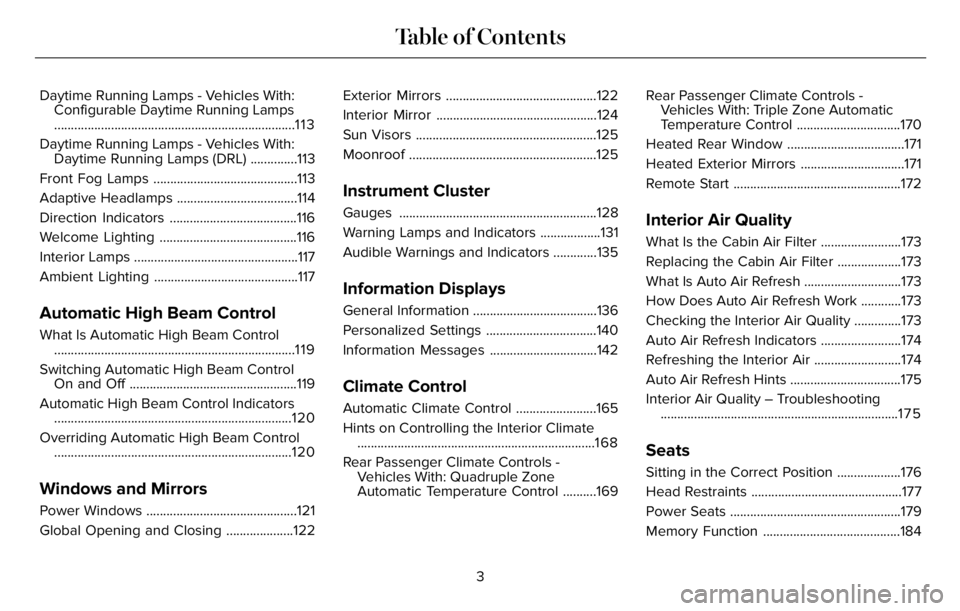
Daytime Running Lamps - Vehicles With:
Configurable Daytime Running Lamps
........................................................................1 1 3
Daytime Running Lamps - Vehicles With:
Daytime Running Lamps (DRL) ..............113
Front Fog Lamps ...........................................113
Adaptive Headlamps ....................................114
Direction Indicators ......................................116
Welcome Lighting .........................................116
Interior Lamps .................................................117
Ambient Lighting ...........................................117
Automatic High Beam Control
What Is Automatic High Beam Control
........................................................................119
Switching Automatic High Beam Control
On and Off ..................................................119
Automatic High Beam Control Indicators
.......................................................................120
Overriding Automatic High Beam Control
.......................................................................120
Windows and Mirrors
Power Windows .............................................121
Global Opening and Closing ....................122Exterior Mirrors .............................................122
Interior Mirror ................................................124
Sun Visors ......................................................125
Moonroof ........................................................125
Instrument Cluster
Gauges ...........................................................128
Warning Lamps and Indicators ..................131
Audible Warnings and Indicators .............135
Information Displays
General Information .....................................136
Personalized Settings .................................140
Information Messages ................................142
Climate Control
Automatic Climate Control ........................165
Hints on Controlling the Interior Climate
.......................................................................168
Rear Passenger Climate Controls -
Vehicles With: Quadruple Zone
Automatic Temperature Control ..........169Rear Passenger Climate Controls -
Vehicles With: Triple Zone Automatic
Temperature Control ...............................170
Heated Rear Window ...................................171
Heated Exterior Mirrors ...............................171
Remote Start ..................................................172
Interior Air Quality
What Is the Cabin Air Filter ........................173
Replacing the Cabin Air Filter ...................173
What Is Auto Air Refresh .............................173
How Does Auto Air Refresh Work ............173
Checking the Interior Air Quality ..............173
Auto Air Refresh Indicators ........................174
Refreshing the Interior Air ..........................174
Auto Air Refresh Hints .................................175
Interior Air Quality – Troubleshooting
.......................................................................1 7 5
Seats
Sitting in the Correct Position ...................176
Head Restraints .............................................177
Power Seats ...................................................179
Memory Function .........................................184
3
Table of Contents
Page 16 of 681
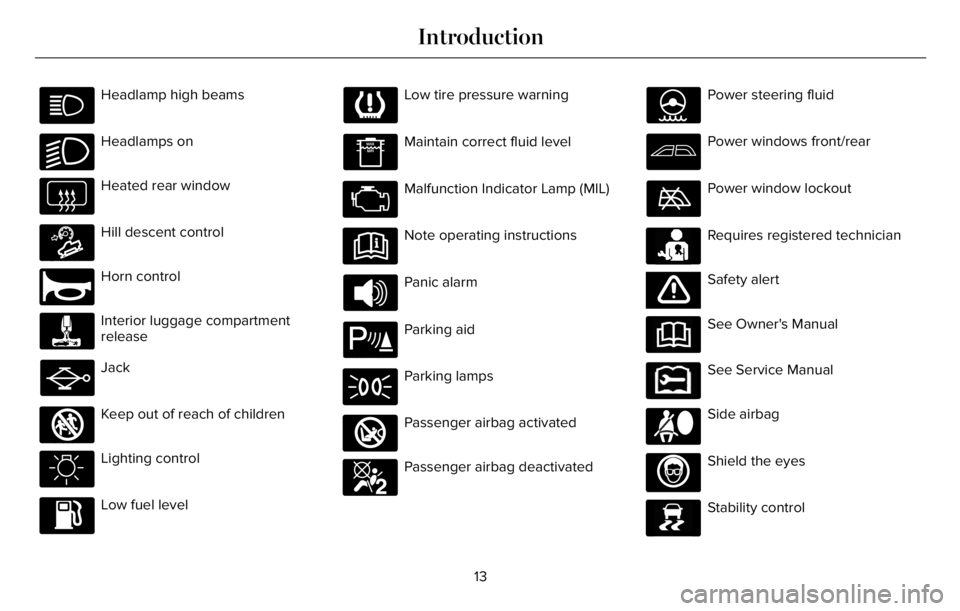
Headlamp high beams
E270968
Headlamps on
Heated rear window
E163171
Hill descent control
E270945
Horn control
Interior luggage compartment
release
Jack
E161353
Keep out of reach of children
Lighting control
Low fuel level
Low tire pressure warning
Maintain correct fluid level
Malfunction Indicator Lamp (MIL)
Note operating instructions
Panic alarm
E139213
Parking aid
Parking lamps
E270849
Passenger airbag activated
E270850
Passenger airbag deactivated
Power steering fluid
Power windows front/rear
Power window lockout
E231159
Requires registered technician
E65963E65963Safety alert
See Owner's Manual
E231158
See Service Manual
Side airbag
Shield the eyes
E138639
Stability control
13
Introduction
Page 18 of 681
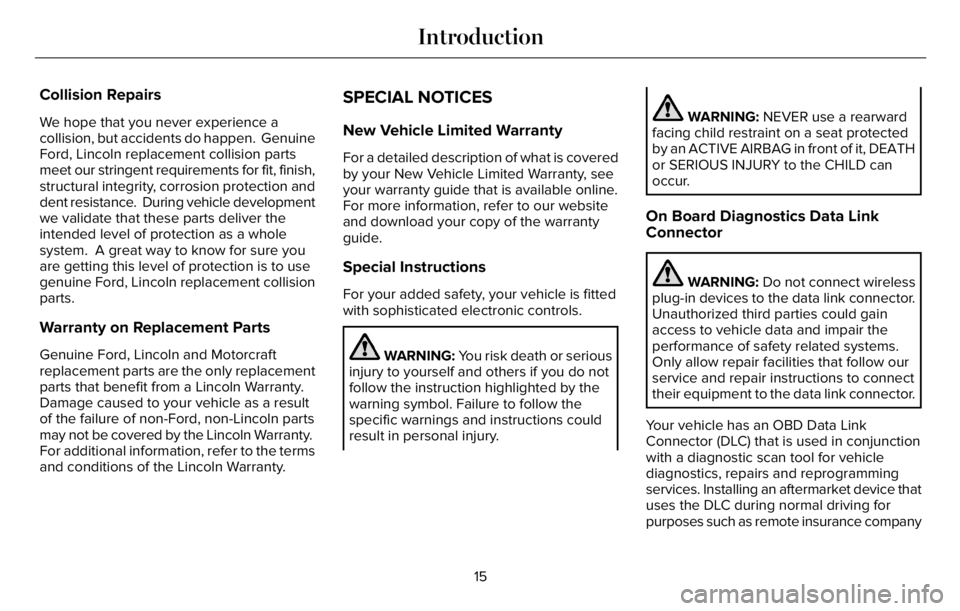
Collision Repairs
We hope that you never experience a
collision, but accidents do happen. Genuine
Ford, Lincoln replacement collision parts
meet our stringent requirements for fit, finish,
structural integrity, corrosion protection and
dent resistance. During vehicle development
we validate that these parts deliver the
intended level of protection as a whole
system. A great way to know for sure you
are getting this level of protection is to use
genuine Ford, Lincoln replacement collision
parts.
Warranty on Replacement Parts
Genuine Ford, Lincoln and Motorcraft
replacement parts are the only replacement
parts that benefit from a Lincoln Warranty.
Damage caused to your vehicle as a result
of the failure of non-Ford, non-Lincoln parts
may not be covered by the Lincoln Warranty.
For additional information, refer to the terms
and conditions of the Lincoln Warranty.
SPECIAL NOTICES
New Vehicle Limited Warranty
For a detailed description of what is covered
by your New Vehicle Limited Warranty, see
your warranty guide that is available online.
For more information, refer to our website
and download your copy of the warranty
guide.
Special Instructions
For your added safety, your vehicle is fitted
with sophisticated electronic controls.
WARNING: You risk death or serious
injury to yourself and others if you do not
follow the instruction highlighted by the
warning symbol. Failure to follow the
specific warnings and instructions could
result in personal injury.
WARNING: NEVER use a rearward
facing child restraint on a seat protected
by an ACTIVE AIRBAG in front of it, DEATH
or SERIOUS INJURY to the CHILD can
occur.
On Board Diagnostics Data Link
Connector
WARNING: Do not connect wireless
plug-in devices to the data link connector.
Unauthorized third parties could gain
access to vehicle data and impair the
performance of safety related systems.
Only allow repair facilities that follow our
service and repair instructions to connect
their equipment to the data link connector.
Your vehicle has an OBD Data Link
Connector (DLC) that is used in conjunction
with a diagnostic scan tool for vehicle
diagnostics, repairs and reprogramming
services. Installing an aftermarket device that
uses the DLC during normal driving for
purposes such as remote insurance company
15
Introduction
Page 33 of 681
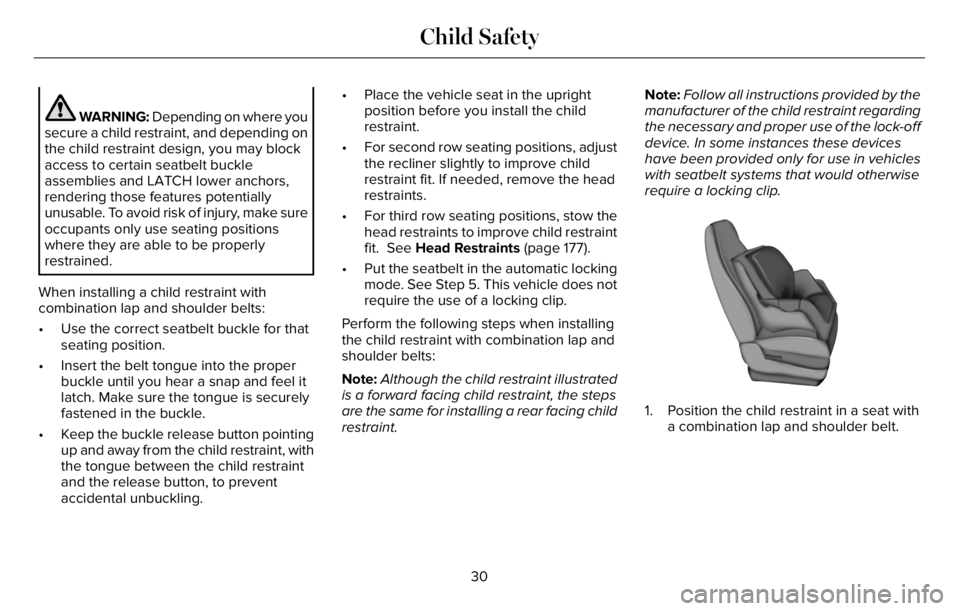
WARNING: Depending on where you
secure a child restraint, and depending on
the child restraint design, you may block
access to certain seatbelt buckle
assemblies and LATCH lower anchors,
rendering those features potentially
unusable. To avoid risk of injury, make sure
occupants only use seating positions
where they are able to be properly
restrained.
When installing a child restraint with
combination lap and shoulder belts:
• Use the correct seatbelt buckle for that
seating position.
• Insert the belt tongue into the proper
buckle until you hear a snap and feel it
latch. Make sure the tongue is securely
fastened in the buckle.
• Keep the buckle release button pointing
up and away from the child restraint, with
the tongue between the child restraint
and the release button, to prevent
accidental unbuckling.• Place the vehicle seat in the upright
position before you install the child
restraint.
• For second row seating positions, adjust
the recliner slightly to improve child
restraint fit. If needed, remove the head
restraints.
• For third row seating positions, stow the
head restraints to improve child restraint
fit. See Head Restraints (page 177).
• Put the seatbelt in the automatic locking
mode. See Step 5. This vehicle does not
require the use of a locking clip.
Perform the following steps when installing
the child restraint with combination lap and
shoulder belts:
Note:Although the child restraint illustrated
is a forward facing child restraint, the steps
are the same for installing a rear facing child
restraint.Note:Follow all instructions provided by the
manufacturer of the child restraint regarding
the necessary and proper use of the lock-off
device. In some instances these devices
have been provided only for use in vehicles
with seatbelt systems that would otherwise
require a locking clip.
E142528
1. Position the child restraint in a seat with
a combination lap and shoulder belt.
30
Child Safety
Page 50 of 681
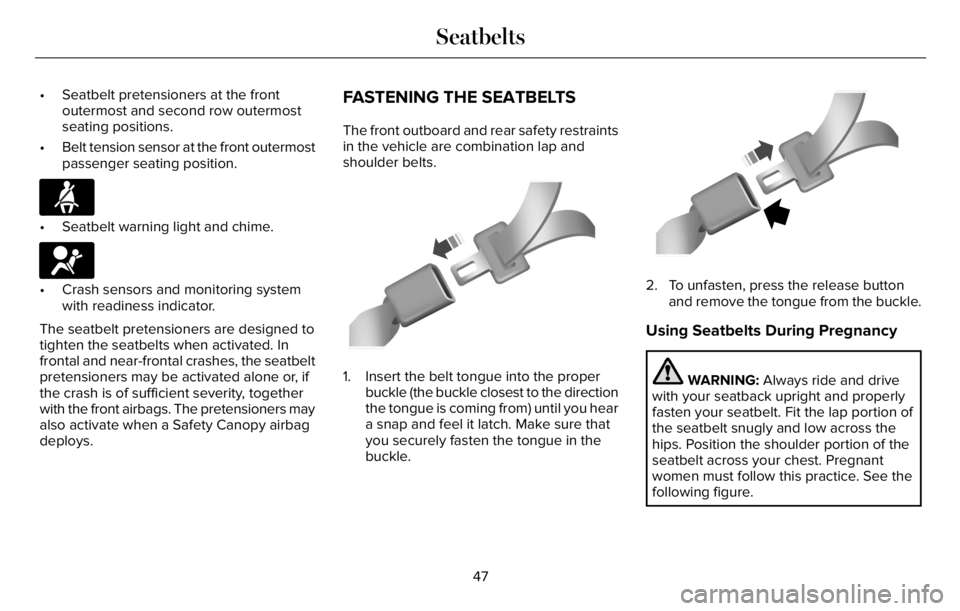
• Seatbelt pretensioners at the front
outermost and second row outermost
seating positions.
• Belt tension sensor at the front outermost
passenger seating position.
E71880€ Seatbelt warning light and chime.
E67017€ Crash sensors and monitoring system
with readiness indicator.
The seatbelt pretensioners are designed to
tighten the seatbelts when activated. In
frontal and near-frontal crashes, the seatbelt
pretensioners may be activated alone or, if
the crash is of sufficient severity, together
with the front airbags. The pretensioners may
also activate when a Safety Canopy airbag
deploys.
FASTENING THE SEATBELTS
The front outboard and rear safety restraints
in the vehicle are combination lap and
shoulder belts.
1. Insert the belt tongue into the proper
buckle (the buckle closest to the direction
the tongue is coming from) until you hear
a snap and feel it latch. Make sure that
you securely fasten the tongue in the
buckle.
2. To unfasten, press the release button
and remove the tongue from the buckle.
Using Seatbelts During Pregnancy
WARNING: Always ride and drive
with your seatback upright and properly
fasten your seatbelt. Fit the lap portion of
the seatbelt snugly and low across the
hips. Position the shoulder portion of the
seatbelt across your chest. Pregnant
women must follow this practice. See the
following figure.
47
Seatbelts
Page 57 of 681
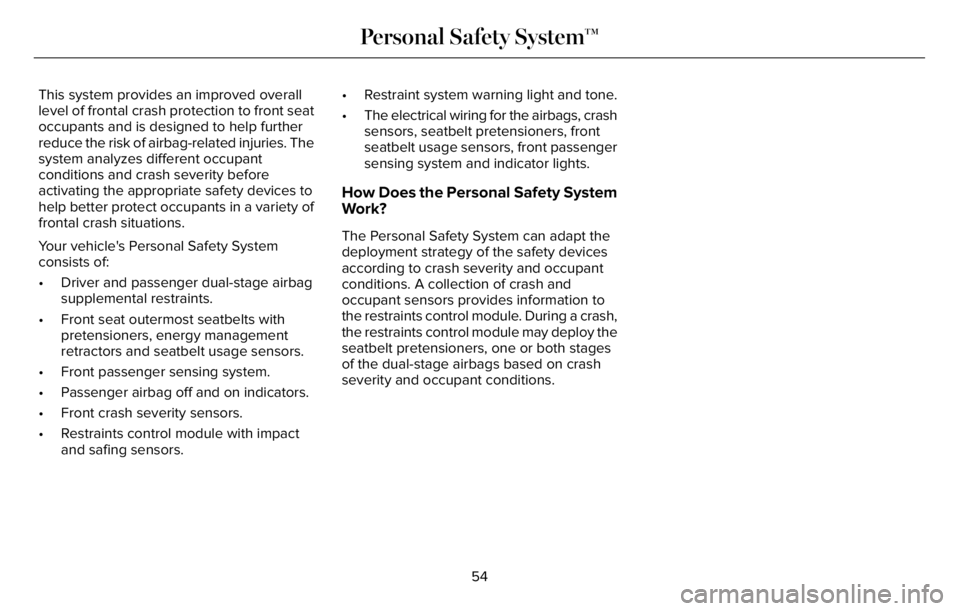
This system provides an improved overall
level of frontal crash protection to front seat
occupants and is designed to help further
reduce the risk of airbag-related injuries. The
system analyzes different occupant
conditions and crash severity before
activating the appropriate safety devices to
help better protect occupants in a variety of
frontal crash situations.
Your vehicle's Personal Safety System
consists of:
• Driver and passenger dual-stage airbag
supplemental restraints.
• Front seat outermost seatbelts with
pretensioners, energy management
retractors and seatbelt usage sensors.
• Front passenger sensing system.
• Passenger airbag off and on indicators.
• Front crash severity sensors.
• Restraints control module with impact
and safing sensors.• Restraint system warning light and tone.
• The electrical wiring for the airbags, crash
sensors, seatbelt pretensioners, front
seatbelt usage sensors, front passenger
sensing system and indicator lights.
How Does the Personal Safety System
Work?
The Personal Safety System can adapt the
deployment strategy of the safety devices
according to crash severity and occupant
conditions. A collection of crash and
occupant sensors provides information to
the restraints control module. During a crash,
the restraints control module may deploy the
seatbelt pretensioners, one or both stages
of the dual-stage airbags based on crash
severity and occupant conditions.
54
Personal Safety System™
Page 60 of 681
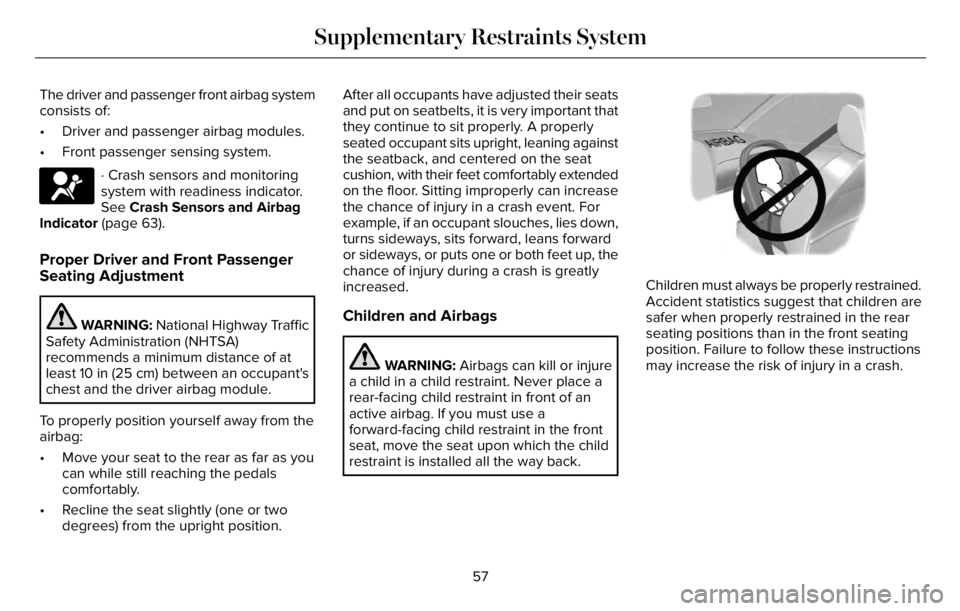
The driver and passenger front airbag system
consists of:
• Driver and passenger airbag modules.
• Front passenger sensing system.
E67017
· Crash sensors and monitoring
system with readiness indicator.
See Crash Sensors and Airbag
Indicator (page 63).
Proper Driver and Front Passenger
Seating Adjustment
WARNING: National Highway Traffic
Safety Administration (NHTSA)
recommends a minimum distance of at
least 10 in (25 cm) between an occupant's
chest and the driver airbag module.
To properly position yourself away from the
airbag:
• Move your seat to the rear as far as you
can while still reaching the pedals
comfortably.
• Recline the seat slightly (one or two
degrees) from the upright position.After all occupants have adjusted their seats
and put on seatbelts, it is very important that
they continue to sit properly. A properly
seated occupant sits upright, leaning against
the seatback, and centered on the seat
cushion, with their feet comfortably extended
on the floor. Sitting improperly can increase
the chance of injury in a crash event. For
example, if an occupant slouches, lies down,
turns sideways, sits forward, leans forward
or sideways, or puts one or both feet up, the
chance of injury during a crash is greatly
increased.Children and Airbags
WARNING: Airbags can kill or injure
a child in a child restraint. Never place a
rear-facing child restraint in front of an
active airbag. If you must use a
forward-facing child restraint in the front
seat, move the seat upon which the child
restraint is installed all the way back.
E142846
Children must always be properly restrained.
Accident statistics suggest that children are
safer when properly restrained in the rear
seating positions than in the front seating
position. Failure to follow these instructions
may increase the risk of injury in a crash.
57
Supplementary Restraints System
Page 66 of 681
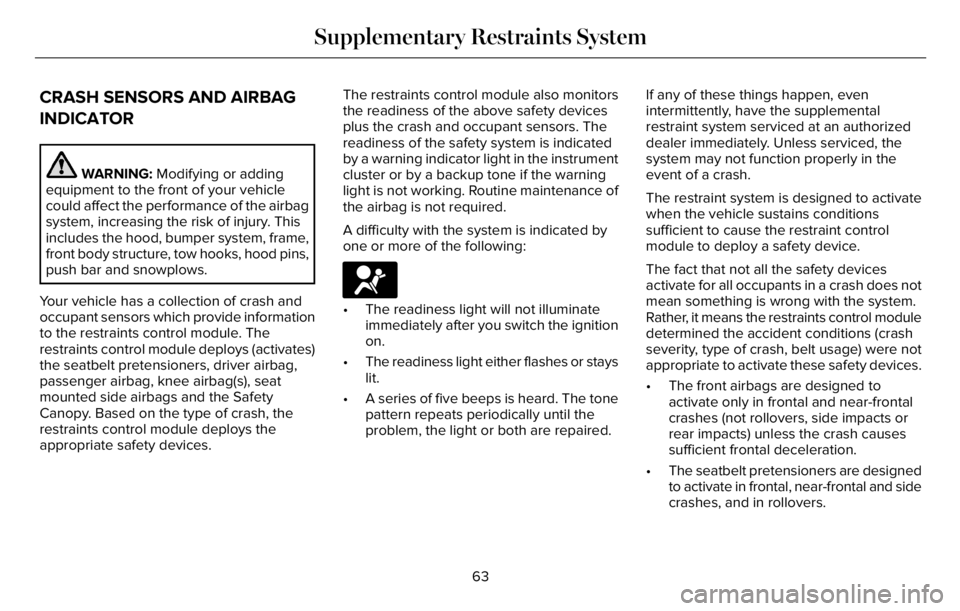
CRASH SENSORS AND AIRBAG
INDICATOR
WARNING: Modifying or adding
equipment to the front of your vehicle
could affect the performance of the airbag
system, increasing the risk of injury. This
includes the hood, bumper system, frame,
front body structure, tow hooks, hood pins,
push bar and snowplows.
Your vehicle has a collection of crash and
occupant sensors which provide information
to the restraints control module. The
restraints control module deploys (activates)
the seatbelt pretensioners, driver airbag,
passenger airbag, knee airbag(s), seat
mounted side airbags and the Safety
Canopy. Based on the type of crash, the
restraints control module deploys the
appropriate safety devices.The restraints control module also monitors
the readiness of the above safety devices
plus the crash and occupant sensors. The
readiness of the safety system is indicated
by a warning indicator light in the instrument
cluster or by a backup tone if the warning
light is not working. Routine maintenance of
the airbag is not required.
A difficulty with the system is indicated by
one or more of the following:
E67017€ The readiness light will not illuminate
immediately after you switch the ignition
on.
€ The readiness light either flashes or stays
lit.
€ A series of five beeps is heard. The tone
pattern repeats periodically until the
problem, the light or both are repaired.If any of these things happen, even
intermittently, have the supplemental
restraint system serviced at an authorized
dealer immediately. Unless serviced, the
system may not function properly in the
event of a crash.
The restraint system is designed to activate
when the vehicle sustains conditions
sufficient to cause the restraint control
module to deploy a safety device.
The fact that not all the safety devices
activate for all occupants in a crash does not
mean something is wrong with the system.
Rather, it means the restraints control module
determined the accident conditions (crash
severity, type of crash, belt usage) were not
appropriate to activate these safety devices.
€ The front airbags are designed to
activate only in frontal and near-frontal
crashes (not rollovers, side impacts or
rear impacts) unless the crash causes
sufficient frontal deceleration.
€ The seatbelt pretensioners are designed
to activate in frontal, near-frontal and side
crashes, and in rollovers.
63
Supplementary Restraints System
Page 115 of 681
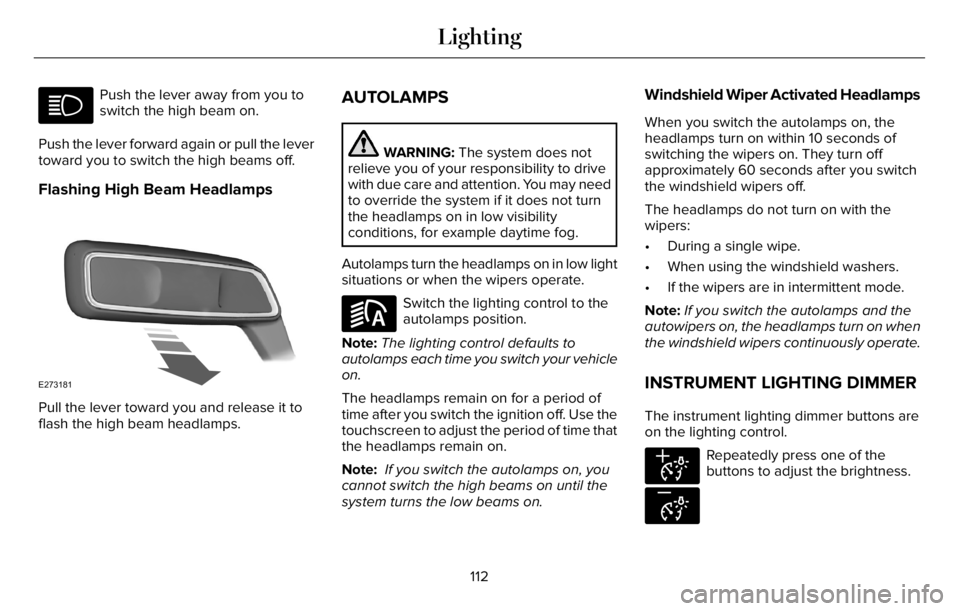
Push the lever away from you to
switch the high beam on.
Push the lever forward again or pull the lever
toward you to switch the high beams off.
Flashing High Beam Headlamps
E273181
Pull the lever toward you and release it to
flash the high beam headlamps.
AUTOLAMPS
WARNING: The system does not
relieve you of your responsibility to drive
with due care and attention. You may need
to override the system if it does not turn
the headlamps on in low visibility
conditions, for example daytime fog.
Autolamps turn the headlamps on in low light
situations or when the wipers operate.
E281240
Switch the lighting control to the
autolamps position.
Note:The lighting control defaults to
autolamps each time you switch your vehicle
on.
The headlamps remain on for a period of
time after you switch the ignition off. Use the
touchscreen to adjust the period of time that
the headlamps remain on.
Note: If you switch the autolamps on, you
cannot switch the high beams on until the
system turns the low beams on.
Windshield Wiper Activated Headlamps
When you switch the autolamps on, the
headlamps turn on within 10 seconds of
switching the wipers on. They turn off
approximately 60 seconds after you switch
the windshield wipers off.
The headlamps do not turn on with the
wipers:
• During a single wipe.
• When using the windshield washers.
• If the wipers are in intermittent mode.
Note:If you switch the autolamps and the
autowipers on, the headlamps turn on when
the windshield wipers continuously operate.
INSTRUMENT LIGHTING DIMMER
The instrument lighting dimmer buttons are
on the lighting control.
E291299
E296433
Repeatedly press one of the
buttons to adjust the brightness.
112
Lighting
Page 116 of 681
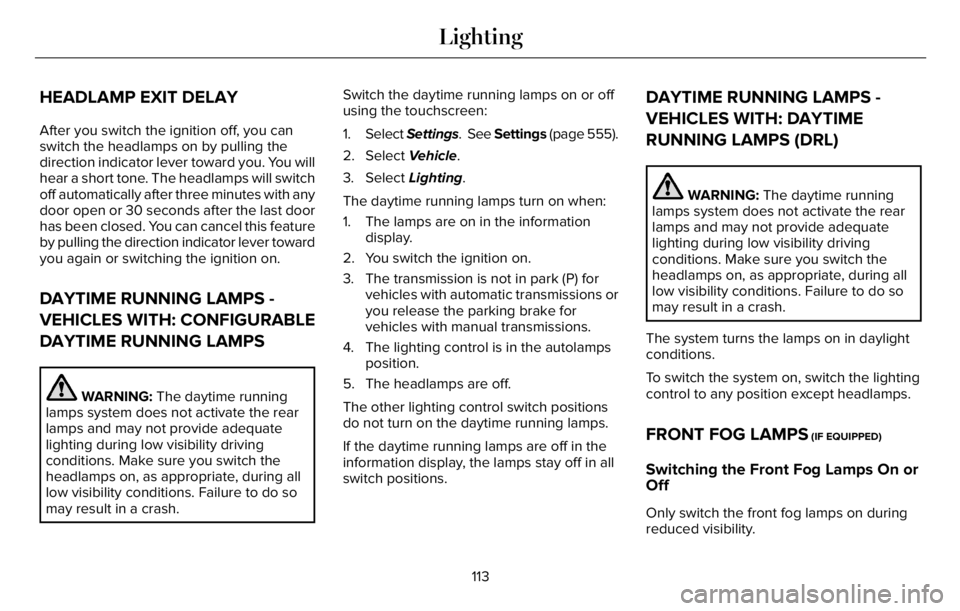
HEADLAMP EXIT DELAY
After you switch the ignition off, you can
switch the headlamps on by pulling the
direction indicator lever toward you. You will
hear a short tone. The headlamps will switch
off automatically after three minutes with any
door open or 30 seconds after the last door
has been closed. You can cancel this feature
by pulling the direction indicator lever toward
you again or switching the ignition on.
DAYTIME RUNNING LAMPS -
VEHICLES WITH: CONFIGURABLE
DAYTIME RUNNING LAMPS
WARNING: The daytime running
lamps system does not activate the rear
lamps and may not provide adequate
lighting during low visibility driving
conditions. Make sure you switch the
headlamps on, as appropriate, during all
low visibility conditions. Failure to do so
may result in a crash.Switch the daytime running lamps on or off
using the touchscreen:
1. Select Settings. See Settings (page 555).
2. Select Vehicle.
3. Select Lighting.
The daytime running lamps turn on when:
1. The lamps are on in the information
display.
2. You switch the ignition on.
3. The transmission is not in park (P) for
vehicles with automatic transmissions or
you release the parking brake for
vehicles with manual transmissions.
4. The lighting control is in the autolamps
position.
5. The headlamps are off.
The other lighting control switch positions
do not turn on the daytime running lamps.
If the daytime running lamps are off in the
information display, the lamps stay off in all
switch positions.
DAYTIME RUNNING LAMPS -
VEHICLES WITH: DAYTIME
RUNNING LAMPS (DRL)
WARNING: The daytime running
lamps system does not activate the rear
lamps and may not provide adequate
lighting during low visibility driving
conditions. Make sure you switch the
headlamps on, as appropriate, during all
low visibility conditions. Failure to do so
may result in a crash.
The system turns the lamps on in daylight
conditions.
To switch the system on, switch the lighting
control to any position except headlamps.
FRONT FOG LAMPS (IF EQUIPPED)
Switching the Front Fog Lamps On or
Off
Only switch the front fog lamps on during
reduced visibility.
113
Lighting